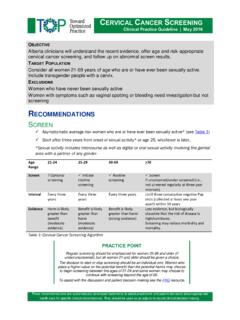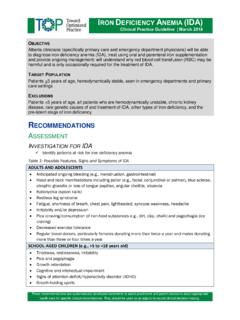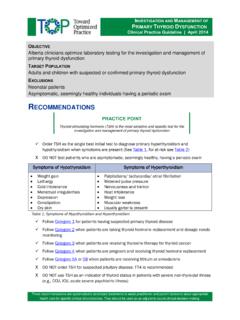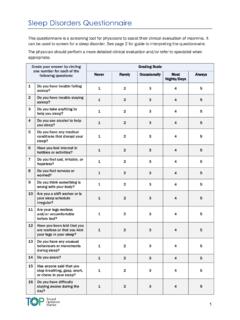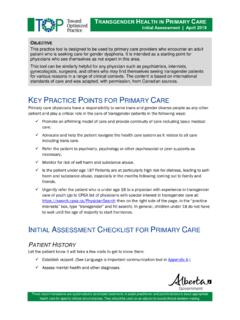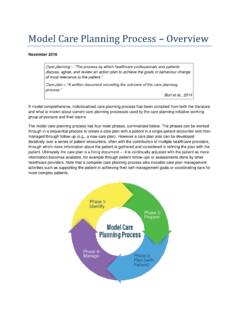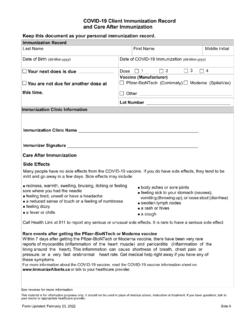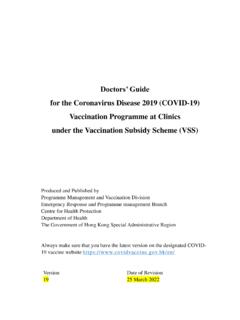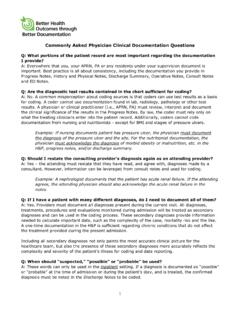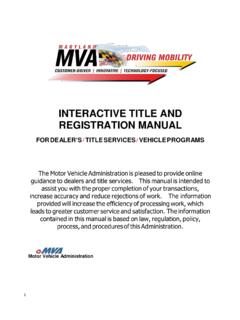Transcription of Quick Reference: GUIDELINE FOR PRIMARY ... - Alberta Doctors
1 NoYe sYe sRed ags:Emergent (address immediately) Thunderclap onset Fever and meningismus Papilloedema (+focal signs or reduced LOC*) Acute glaucoma Ye sRefer and/or investigateHeadache with 2 or more of: Nausea Light sensitivity Interference with activitiesPractice points: Migraine historically under diagnosed Consider migraine diagnosis for recurring sinus headacheHeadache w/o nausea and 2 or more of: Bilateral headache Non pulsating pain Mild to moderate pain Not worsened by activityAll of: Frequent headache Severe Brief < 3 hours per attack Unilateral (always same side) Ipsilateral eye redness, tearingand/or restlessness during attacksAll of: Unilateral headache (always same side) Continuous Dramatically responsive to indomethacinHeadache continuous since onsetMedication overuse.
2 Assess Ergots, triptans, combinationanalgesics or codeine/otheropioids 10 days a monthOR Acetaminophen or NSAIDs 15days a monthManage Educate patient Consider prophylacticmedication Provide an effective acute medfor severe attacks with limitations on frequency of use Gradual withdrawal if opioid, or combination analgesic with opioid or barbiturate Abrupt (or gradual) withdrawalif acetaminophen, NSAIDs, ortriptan Tension type headache Acute medication (Table 2) Monitor for medication overuse Prophylactic medication if disabilitydespite acute meds (Table 2)Cluster headache or another trigeminal autonomic cephalalgia Management primarily pharmacological Acute medication (Table 3) Prophylactic medication (Table 3) Early specialist referral recommendedMigraine Acute medication (Table 1) Monitor for medication overuse Prophylactic medication (Table 1), ifheadache.
3 > 3 days/month and acutemeds not effectiveOR> 8 days/month (risk of overuse)ORDisability despite acute medsYe sMigraineYe sTension-typeHeadacheHemicrania continua Specialist referralNew daily persistent headache Specialist referralYe sNoThe above recommendations are systematically developed statements to assist practitioner and patient decisions about appropriate health care for specific clinical circumstances. They should be used as an adjunct to sound clinical decision management Headache diary: record frequency,intensity, triggers and medication Adjust lifestyle factors: reducecaffeine, ensure regular exercise, avoidirregular and/or inadequate sleep or meals Stress management: relaxation training, CBT*, pacing activity, biofeedback Uncommon headache syndromesNoUrgent (address hours to days) Temporal arteritis Papilloedema (NO focal signs or reduced LOC*) Relevant systemic illness Elderly: new headache with cognitive change Possible indicators of secondary headache.
4 Unexplained focal signs Atypical headaches Unusual headache precipitants Onset after age 50 Aggravation by neck movement; abnormalneck exam. Consider cervicogenic headache. Jaw symptoms; abnormal jaw exam. Considertemporomandibular disorder. Quick Reference: GUIDELINE FOR PRIMARY CARE MANAGEMENT OF HEADACHE IN ADULTS September 2016*LOC - loss of consciousness*CBT - cognitive behavioural therapy Table 2: Tension-Type Headache Acute Medication ibuprofen 400 mg ASA 1,000 mg naproxen sodium 550 mg acetaminophen 1,000 mg Prophylactic Medication 1st line amitriptyline 10-100 mg hs OR nortriptyline 10-100 mg hs 2nd line mirtazapine 30 mg hs OR venlafaxine 150 mg once daily Table 3.
5 Cluster Headache (consider early specialist referral) Acute Medication subcutaneous sumatriptan 6 mg intranasal zolmitriptan 5 mg or sumitriptan 20 mg OR 100% oxygen at 12 litres/minute for 15 minutes through non-rebreathing mask *Prophylactic Medication 1st line verapamil 240-480 mg per day (higher doses may be required) 2nd line lithium 900-1,200 mg per day Other topiramate 100-200 mg per day OR melatonin up to 10 mg hs *Note: If more than two attacks per day, consider transitional therapy while verapamil is built up ( , prednisone 60 mg for five days, then reduced by 10 mg every two days until discontinued, or occipital nerve blockage with steroids by trained physicians).
6 Table 1: Migraine Acute Migraine Medication 1st line ibuprofen 400 mg, ASA 1,000 mg, naproxen sodium 550 mg, acetaminophen 1,000 mg, diclofenac 50 mg 2nd line Triptans: oral sumatriptan 100 mg, rizatriptan 10 mg, almotriptan mg, zolmitriptan mg eletriptan 40 mg, frovatriptan mg, naratriptan mg Subcutaneous sumatriptan 6 mg if vomiting early in the attack. Consider for attacks resistant to oral triptans. Oral wafer: rizatriptan 10 mg, zolmitriptan mg, if fluid ingestion worsens nausea Nasal spray: zolmitriptan 5 mg, sumatriptan 20 mg, if nausea Antiemetics: domperidone 10 mg, metoclopramide 10 mg, for nausea 3rd line 550 mg naproxen sodium in combination with triptan 4th line Fixed-dose combination analgesics (with codeine if necessary - not recommended for routine use) Prophylactic Migraine Medication Starting Dose *Titration.
7 Daily Dose Increase Target Dose / Therapeutic Range notes 1st line propranolol 20 mg bid 40 mg/week 40-120 mg bid Avoid in asthma metoprolol 50 mg bid 50 mg/week 50-100 mg bid nadolol 20-40 mg once daily 20 mg/week 80-160 mg daily amitriptyline 10 mg hs 10 mg/week 10-100 mg hs Consider if depression, anxiety, insomnia or tension-type headache nortriptyline 10 mg hs 10 mg week 10-100 mg hs 2nd line topiramate 25 mg once daily 25 mg/week 50 mg bid Consider 1st line if overweight candesartan 8 mg once daily 8 mg/week 16 mg once daily Few side effects; avoid in pregnancy or when pregnancy is planned lisinopril 10 mg once daily 10 mg/week 20 mg once daily More side effects than candesartan.
8 Avoid in pregnancy or when pregnancy is planned Other divalproex sodium 250 mg once daily 250 mg/week 750-1,500 mg daily, divided bid Avoid in pregnancy or when pregnancy is planned pizotifen mg daily mg/week 1-2 mg bid Monitor for somnolence and weight gain OnabotulinumtoxinA 155-195 units No titration needed 155-195 units every 3 months For chronic migraine only headache on 15 days per month flunarizine 5-10 mg hs 10 mg hs Avoid in depression venlafaxine mg once daily mg/week 150 mg once daily Consider in migraine with depression and/or anxiety Over the Counter magnesium citrate 300 mg bid No titration needed 300 mg bid Efficacy may be limited; few side effects riboflavin 400 mg daily 400 mg daily co-enzyme Q10 100 mg tid 100 mg tid *Titration: Dosage may be increased every two weeks to avoid side effects For most drugs, slowly increase to target dose Therapeutic trial requires several months Expected outcome is reduction, not elimination of attacks If target dose not tolerated, try lower dose If med effective and tolerated, continue for at least six months If several preventive drugs fail, consider specialist referral Quick Reference.
9 MEDICATIONS RECOMMENDED FOR HEADACHE MANAGEMENT IN ADULTS Refer to full GUIDELINE for migraine treatment in pregnancy and lactation September 2016 Abbreviations: hs at bedtime; bid twice a day; tid three times a day These recommendations are systematically developed statements to assist practitioner and patient decisions about appropriate health care for specific clinical circumstances. They should be used as an adjunct to sound clinical decision making. KEY MESSAGES* DIAGNOSIS AND IMAGING Rule out secondary headache when making a diagnosis of a PRIMARY headache disorder. Neuroimaging is not indicated in patients with recurrent headache with the clinical features of migraine, a normal neurological examination, and no red flags.
10 Neuroimaging, sinus X-rays, cervical spine X-rays, and EEG are not recommended for the routine assessment of the patient with headache. History and physical/neurological examination is usually sufficient to make a diagnosis of migraine or tension-type headache. DIFFERENTIAL DIAGNOSIS Migraine is by far the most common headache type in patients seeking help for headache from physicians. Migraine is historically under-diagnosed and under-treated. Many patients with migraine are not diagnosed with migraine when they consult a physician. Migraine should be considered in patients with recurrent moderate or severe headaches and a normal neurological examination. Patients consulting for bilateral headaches which interfere with their activities are likely to have migraine rather than tension-type headache and may require migraine specific medication.

